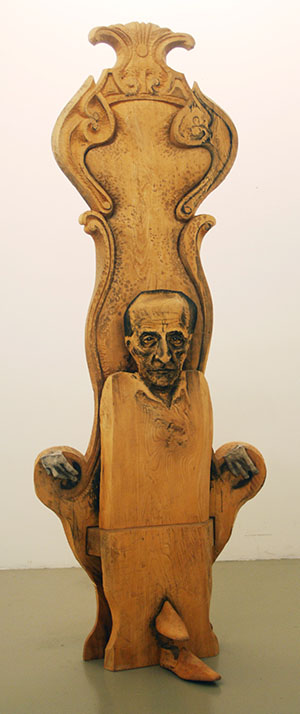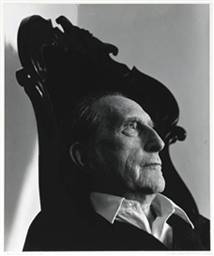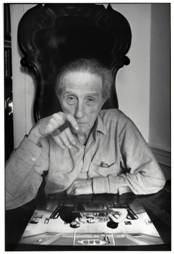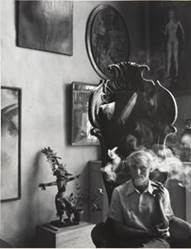


Portrait of Marcel Duchamp, 1981
Charcoal on carved wood, 87 1/2 x 32 1/8 x 14 inches
Marisol’s portrait of Marcel Duchamp is based on photographs of the artist seated in a large, carved oak high-back chair. The elaborate chair was given to Duchamp as a gift by Max Ernst when he and his wife Dorothea Tanning returned to France in 1955. Before he gave it to Duchamp, Ernst was photographed seated in the chair by Arnold Newman (Fig. 1), and later, Duchamp was also photographed comfortably relaxing in this same chair in his West 10th Street apartment: pictures taken by Arnold Newman (Fig. 2), Ugo Mulas (Fig 3), and others.



The Duchamp portrait was part of a series of sculptures executed by Marisol between 1977 and 1981 called “Artists and Artistes,” which consisted of well-known personalities in the world of art, artists, writers, composers and dancers whom she admired: Pablo Picasso, Willem de Kooning, Louise Nevelson, Georgia O’Keeffe, Martha Graham, Virgil Thompson, William Burroughs, and of course, Marcel Duchamp (with the exception of Picasso, she had known all of them personally). As the art historian Roberta Bernstein noted, Marisol chose to depict these individuals at the time when she met them, most of whom were by then advanced in age. “They are all among the successful elders in their respective arts who have continued throughout their long lives to be active and productive,” she wrote. “In addition, each has played a role in Marisol’s personal life and/or artistic development.” (Arts, p. 112).
As Bernstein also noted “Marisol creates the effect of aging skin by her technique of chipping away at the wood and leaving it rough, as well as by ingeniously utilizing the cracks and woodgrain to suggest creases and wrinkles… A thin, elegant, cerebral Duchamp sits in a cross-legged pose in his famous, towering, high-backed chair. The most defined part of his figure is the head, while the rest of the body is relatively flat and dematerialized” (Arts, pp. 113-14). When Marisol saw the sculpture many years later, she told the collector who owned it at the time that she depicted Duchamp with his feet crossed because that’s the position he assumed when playing chess. According to what she understood, it helped him concentrate. It may have been for this reason that she rendered the artist with a somewhat stern expression on his face, as if he were intently engaged in an effort to solve an unusually difficult position.